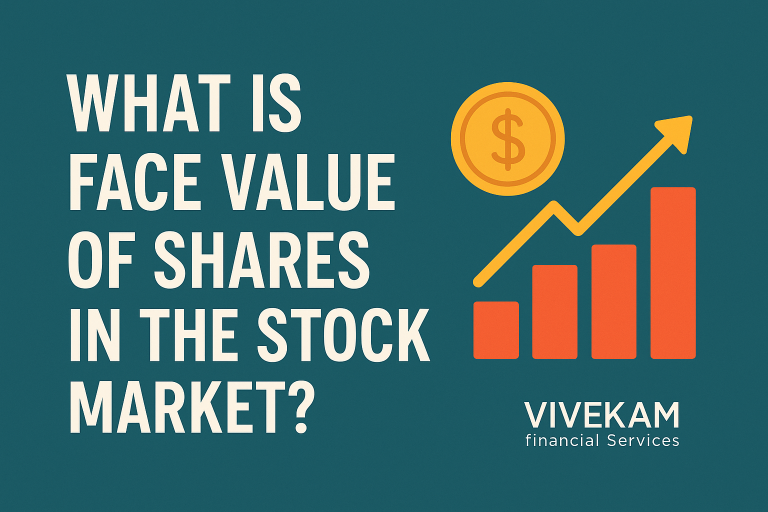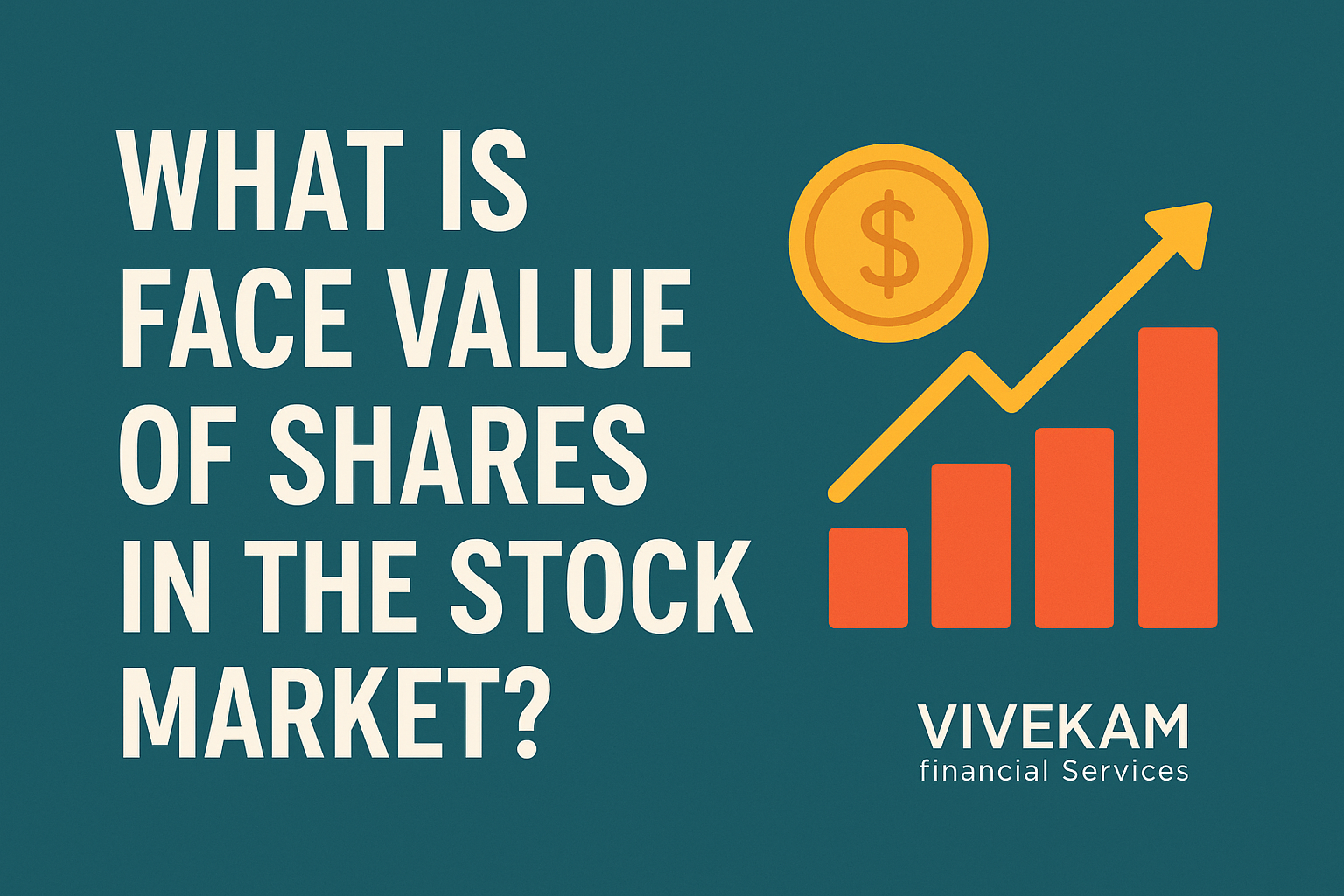What is the Face Value of Shares in the Stock Market?

Understanding the Basic Concept of Face Value
What is Face Value?
Face value is the nominal, original, or printed value of a share decided by the company at the time of issuance. It acts as the foundation for accounting entries and legal share capital.
Unlike market price, it doesn’t bounce up and down every second—it stays steady unless the company performs a stock split or reverse split.
Face Value Meaning Explained
When investors talk about face value meaning, they’re referring to the value assigned to each share on paper. It’s the baseline number companies use for:
- share capital
- dividends
- bond calculations
- regulatory compliance
Even though it may seem like a tiny technical detail, it matters more than most people realize.
How Face Value Works in Stocks
What is the Face Value of Share?
Face value of a share—also called par value—is printed on the share certificate and used to compute several financial metrics. It doesn’t represent the actual trading price (that’s market value), but it does help define:
- paid-up capital
- dividend percentages
- shareholder equity structure
Face Value in Company Balance Sheet
In the company’s balance sheet, face value appears under Share Capital. Every company reports:
- Authorized share capital (based on face value)
- Issued share capital
- Paid-up share capital
This ensures financial transparency and regulatory compliance.
How Face Value is Decided
Who Determines Face Value?
Face value is chosen by:
- Founders
- Board of Directors
- Company’s Articles of Association
Values commonly used are ₹1, ₹2, ₹5, and ₹10, mostly for convenience.
How Face Value is Calculated for Shares
There is no mathematical formula for deciding face value. Instead, companies choose a number that:
- fits industry norms
- simplifies accounting
- supports future stock splits
Face Value Formula
Though face value has no set formula, investors can calculate related figures using:
Share Capital = Number of Shares × Face Value
Example:
If a company has ₹40,00,000 in share capital and face value is ₹10:
Number of shares = 40,00,000 ÷ 10 = 4,00,000 shares
It’s simple, clean, and used by accountants everywhere.
Examples of Face Value in Stock Market
|
Company |
Face Value |
Market Price |
Explanation |
|
Company A |
₹10 |
₹800 |
Market price high, face value unchanged |
|
Company B |
₹1 |
₹150 |
Low face value due to stock split |
|
Company C |
₹5 |
₹35 |
Market sentiment decides price, not face value |
These examples show that face value doesn’t dictate investor demand. It only sets the company’s internal structure
Face Value vs Market Value
|
Basis |
Face Value |
Market Value |
|
Meaning |
Nominal printed value |
Actual trading value |
|
Set by |
Company |
Market forces |
|
Frequency of Change |
Rare |
Constant |
|
Used For |
Dividends, share capital |
Buying/selling decisions |
Face value is accounting-oriented.
Market value is investor-oriented.
Face Value vs Market Value vs Book Value
|
Metric |
Meaning |
Controlled By |
Key Role |
|
Face Value |
Fixed nominal value |
Company |
Share capital structure |
|
Market Value |
Real-time price |
Market |
Profit/loss for investors |
|
Book Value |
Assets – liabilities per share |
Company’s financial health |
Valuation indicator |
Importance of Face Value in Stock Market
Face value plays a key role in:
- determining dividend payouts
- structuring equity capital
- IPO pricing
- calculating bond interest
- guiding stock split ratios
Even though traders rarely look at it, analysts and companies rely on it daily.
Role of Face Value in IPO
IPO pricing is built on:
IPO Price = Face Value + Premium
For example:
If IPO price = ₹500 and face value = ₹10, the premium = ₹490.
Face value helps determine lot sizes and minimum investment amounts.
Face Value Impact on Share Price
While face value doesn’t directly affect market price, changes in face value do:
Example (Stock Split):
Face value: ₹10 → ₹1
Shares multiply 10×
Market price typically adjusts downward to maintain market capitalization.
This increases liquidity and makes the stock accessible to more investors.
Importance of Par Value in Calculating Dividends
Dividends are usually declared as a percentage of face value:
If a company declares a 200% dividend on a face value of ₹5:
Dividend = 200% of 5 = ₹10 per share
This is why par value (face value) matters for income-focused investors.
Is Face Value the Same as Par Value?
Yes—face value and par value are used interchangeably.
Both refer to the share’s nominal value printed on official documents.
What Investors Should Know About Face Value
Investors should remember:
- Dividends are tied to face value
- IPOs use face value as their base
- Stock splits adjust face value
- Market price and face value are NOT connected
- Book value and market value depend on company fundamentals
Understanding face value helps decode financial statements more confidently
FAQs About Face Value of Shares
1. What is face value in the stock market?
It is the nominal value of a share used in accounting and legal capital.
2. Why is face value important?
It helps calculate dividends, share capital, IPO pricing, and bond interest.
3. Does face value affect market price?
No. Market price is driven by demand, supply, and company performance.
4. Can face value change?
Yes—during stock splits or reverse splits.
5. Is face value the same as par value?
Yes. They are the same concept with different names.
6. How is face value shown in the balance sheet?
Under the “Share Capital” section, multiplied by the number of issued shares.
Conclusion
Knowing What is the Face Value of Shares in the Stock Market? helps investors understand dividends, share capital, IPO structures, and the inner mechanics of corporate finance. While face value doesn’t dictate market performance, it is a core part of how companies are built and valued on paper. With this knowledge, investors can interpret financial documents with much more clarity.







